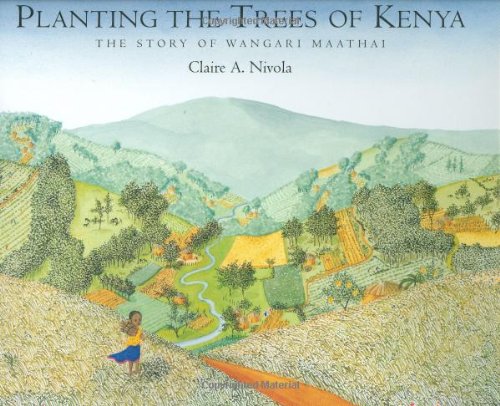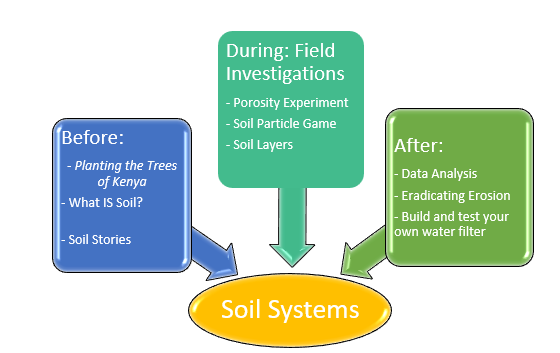Designed for 3rd grade
$4 per student
With this investigative program, students realize that soil is more than just dirt! The science process skills of data collection, measurement, and observation are reinforced. In collaborative groups, your soil scientists conduct an experiment to test soil porosity and explore soil particle size during a kinesthetic game. In the field, we examine and identify different soil layers and look for evidence of organisms living in the soil. Observe evidence of erosion, and discuss potential implications in the watershed.
Target SOL (for the field investigation. Additional SOL apply to the before and after activities.) Science (2018) 3.1, 3.6, 3.8 Math (2023) 3.NS.3, 3.CE.1, 3.MG.1, 3.MG.3, 3.PS.1 English (2024) 3.C.1, 3.RV.1, 3.RI.3
To enhance classroom connections with the field experience, we have developed this lesson cluster. Field investigations are more meaningful to students when integrated into their curriculum. This lesson cluster can be used to: introduce soil concepts, increase depth of knowledge by synthesizing a variety of components in a systems approach, and develop student collaboration and cooperation with an action project. Before-visit activities increase student awareness of the process of science, and understanding of soil, and create literacy connections with historical conservation figures. With the after-visit activities, students synthesize concepts gathered in the field as they plan and execute an action or community science project. Click on each section below to learn more about the cluster's activities. Click here for the full lesson cluster (see each section for individual activity plans).
NOTE: hover over bolded phrases to find links to resources
Before: Building Understanding of Soil Science & Conservation Figures in Soil
Before-visit activities increase awareness of soil science and create literacy connections with historical conservation figures.
Before 1- Planting the Trees of Kenya
During: Field Investigations
During your field investigation at Blandy, your students will engage in several indoor and outdoor lessons where they conduct scientific experiments and tactile investigations of soil to understand soil composition. Below is an overview of the “standard” program activities to assist you with integrating this field experience into the classroom experiences. This will change due to weather, the volume of students, or communication with environmental educators. Click here for a sample schedule (will vary depending on the number of classes).
Soil Porosity Experiment- Your soil scientists conduct experiments to determine how water moves through different particles. Measurements are made, and data are collected in an enriching experiment of science process skills.
Soil Particles- Students model soil particle sizes and understand how erosion impacts soils.
Soil Layers- Soil Composition is examined, asking, "How is soil a system?" and "What is soil composed of?"
VA Standards Addressed:
Science (2018) 3.1, 3.6, 3.8
Math (2023) 3.NS.3, 3.CE.1, 3.MG.1, 3.MG.3, 3.PS.1
English (2024) 3.C.1, 3.RV.1, 3.RI.3
After: Data Analysis & Applying Soil Knowledge to the Schoolyard
With the after-visit activities, students synthesize concepts gathered in the field as they plan and execute an action or community science project. And students analyze data to make conclusions.
After 2- Eradicating Erosion in the Schoolyard Action Project
Literacy

Muddy Max: The Mystery of Marsh Creek Fiction
Author: Elizabeth Rusch Illustrator: Mike Lawrence
Grades 4-6 Lexile: NA
Suggested Activities:
- Many of the organisms that live in soil are addressed in this book. Conduct additional research and make a soil ecosystem food web. Do different organisms have different soil habitat needs?
- Have students think about soil particles. Would sandy mud endow different superpowers than clayey mud? Have students bring different soil samples from outside of school, assess their texture, and use the particle characteristics to create new superpowers for Max.
- Additional activities included in the back of the book, including: Soil Close-up (examining a soil sample), Make Some Mud (exploratory activity mixing water and soil), Breathing Mud Creatures (testing living creatures in soil), learning about Antoni Gaudi and making drip sculptures, Making Mud Bricks, and Ancient and Modern Mud Houses. "
 Planting the Trees of Kenya: The Story of Wangari Maathai Non-fiction
Planting the Trees of Kenya: The Story of Wangari Maathai Non-fiction
Author: Claire A. Nivola
National Geographic text alignment: Ladders: Mountains, Valleys, and Plains
Grade: K-3rd Lexile: AD870L
Under your Feet: Soil, Sand and Everything Underground Non-fiction
Author: Wenjia Tang
Grade: K-3rd Lexile: IG840L
Under Your Feet delves beneath the Earth’s surface and explores the diverse wonders hidden there. Encounter creatures of the deep and marvel at the mind-boggling size of the humongous fungus – the biggest organism in the world. Learn how one handful of ordinary soil contains more organisms than people on Earth, and experiment using dirt from your own back garden.
Suggested Activities:
- Prior to reading, make a water and soil map of the schoolyard. Where do students see bare soil? Where do they see evidence of water (gutters, downspouts, storm drains…) Are there any connections between bare soil and water? Read the story and revisit the maps/schoolyard. Why do students think the soil is bare in places? What are the possible consequences? How could they help?


